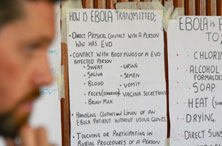 A member of a Rapid Response Team receives training on Ebola in Sudan (Photo: WHO).
A member of a Rapid Response Team receives training on Ebola in Sudan (Photo: WHO).
Ebola virus disease (EVD) is a severe illness that is often fatal in humans if untreated. Ebolavirus is a genus of the virus family Filoviridae, which also includes the genera Cuevavirus, and Marburgvirus, and includes 5 species of Ebola: Zaire, Bundibugyo, Sudan, Reston and Taï Forest.
First symptoms are the sudden onset of fever fatigue, muscle pain, headache and sore throat. This is followed by vomiting, diarrhoea, rash, symptoms of impaired kidney and liver function, and in some cases, both internal and external bleeding (e.g. oozing from the gums, blood in the stools). Laboratory findings include low white blood cell and platelet counts and elevated liver enzymes.
The virus is transmitted to people from wild animals and spreads in the human population via direct contact with blood, secretions, organs or other bodily fluids of infected people, and with surfaces and materials (e.g. bedding, clothing) contaminated with these fluids. Health-care workers have frequently been infected while treating patients with suspected or confirmed EVD, through close contact with patients when infection control precautions are not strictly practiced. Burial ceremonies that involve direct contact with the body of the deceased can also contribute to the transmission of Ebola. More surveillance data and research are needed on the risk of sexual transmission, and particularly on the prevalence of viable and transmissible virus in semen over time.
EVD on average kills half of those it infects, though fatality rates have varied from 25% to 90% in past outbreaks. The virus first appeared in 1976 in two simultaneous outbreaks in what is now South Sudan, and in the Democratic Republic of Congo, near the Ebola River from which the disease takes its name. The 2014–2016 outbreak in Sierra Leone, Liberia and Guinea, which was caused by the Zaire species, was the largest and most complex Ebola outbreak ever, with over 28,000 cases and more than 11,000 deaths. In addition to the direct health impact, the outbreak and associated fears and stigma caused severe damage and disruption to local economies and daily life. The same virus species re-emerged in the Democratic Republic of the Congo in 2017 and again in May and August of 2018.
To date, no EVD cases have been recorded in the Eastern Mediterranean Region. Between October 2014 and February 2015, 20 out of 22 countries in the Region conducted a rapid assessment of their preparedness and readiness measures for Ebola. Any gaps were addressed through a 90-day action plan addressing leadership and coordination, capacities at border crossings, surveillance and contact tracing, laboratory detection and diagnosis, case management and infection prevention and control, risk communication, and safe burials.





